

Last week, The English Apple Man joined fellow members of East Kent Fruit Society (EKFS) at Bekesbourne Farm for the traditional walk of the Winning Orchard of EKF Society's annual orchard competition.
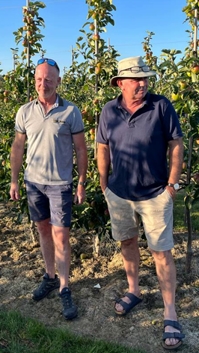 Brothers William & David Riccini grow apples. pears, and cherries on four farms in East Kent. They have an envious record as multiple winners of this prestigious award.
Brothers William & David Riccini grow apples. pears, and cherries on four farms in East Kent. They have an envious record as multiple winners of this prestigious award.
Their 3 other farms cover 73 hectares, mainly Gala and Braeburn, a few Cameo and Conference pears..
David said, "We picked a total of 9,200 bins in 2022 from all sites, maybe less in 2023, we have a slightly reduced Gala crop and have grubbed 2 hectares of Michgla an older clone of Gala.
See below a link to The Riccini brothers EKFS Winning Orchard Walk in 2019.
Click on: EKFS Winning Orchard Walk 2019 at Oast House Farm.
The English Apple Man Comments: The Riccini brothers farms are and always have been 'smart well managed enterprises' and this was evident on this beautiful summers evening, as I entered the driveway, the consistency of tree management and crop was 'striking'
Bekesbourne Farm is a mix of Apples, Pears and Cherries
Tunnelled Cherries cover an area of 3 hectares, ranging from 2 years to 15 years old.
Below: Will Riccini leads EKFS members on the tour of Bekesbourne, here past the cherry tunnels.
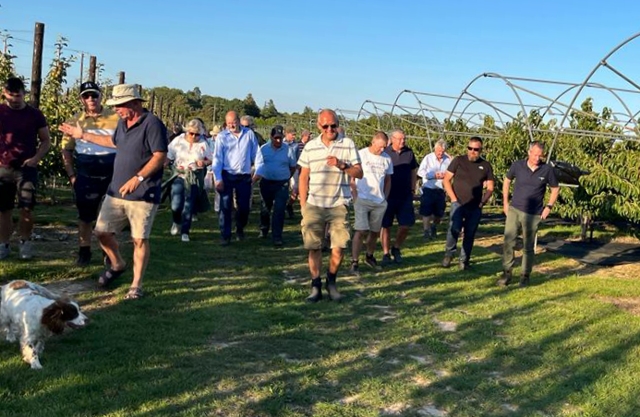 Varieties: latest planting is Grace Star, 1 hectare. Older varieties are Kordia, Regina and Karina.
Varieties: latest planting is Grace Star, 1 hectare. Older varieties are Kordia, Regina and Karina.
Below: Grace Star
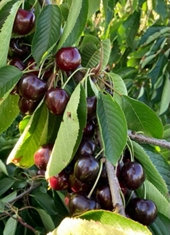
The English Apple Man visited Bekesbourne in 2015 when the cherries were in 'full flow'
Click on English Apple Man Journal for July 2015. Report on visit to Bekesbourne Cherries in 2015.
The Conference pears with Comice pears as pollinators were planted in 1974 (pears for your heirs!) at 11ft x 5ft and average yield only 25 tonnes per hectare, although the Riccini brothers think this year's crop may reach 30 tones per hectare
Below: left. Conference Pears and right. Comice Pears at Bekesbourne
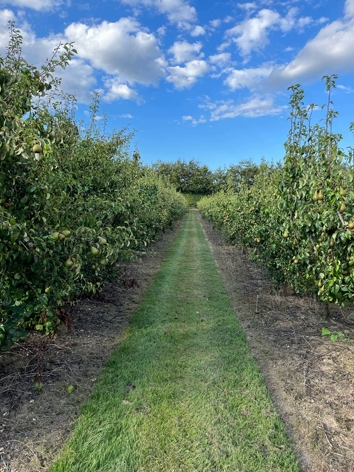
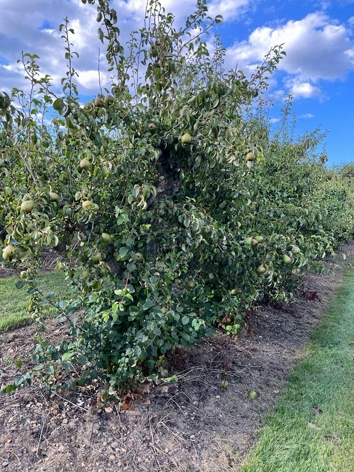
Below: left. Conference Pears 'close up' and right. Comice Pears 'close up' at Bekesbourne
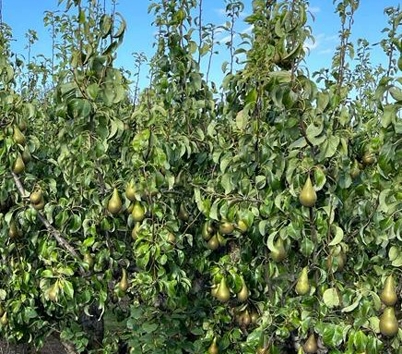
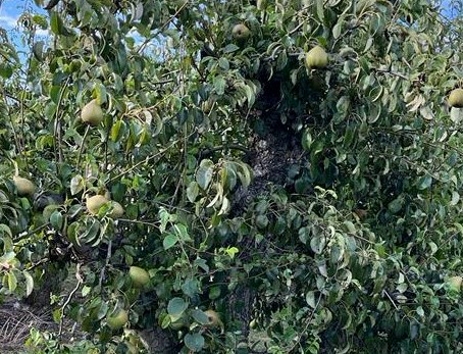
Magic Star
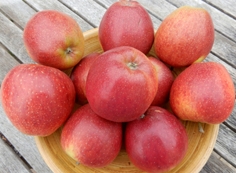 The Riccini brothers reason for choosing magic star, aside from being a beautiful looking and tasting apple, (it has a wholesome, slightly old fashioned appearance rather than the perfect uniformity of many modern selections), the ability to store the fruit beyond a year gives our marketing agent the ability to say 'No', I don't need to sell it now, we can wait for better prices, avoiding the pitfalls of having stores full of fruit losing pressure and begging for a promotion to shift it quickly at no money!
The Riccini brothers reason for choosing magic star, aside from being a beautiful looking and tasting apple, (it has a wholesome, slightly old fashioned appearance rather than the perfect uniformity of many modern selections), the ability to store the fruit beyond a year gives our marketing agent the ability to say 'No', I don't need to sell it now, we can wait for better prices, avoiding the pitfalls of having stores full of fruit losing pressure and begging for a promotion to shift it quickly at no money!
There's no decent early dessert variety.....so could be sold in August the following year perhaps?
The first Magic Star, 2.5 hectares, was planted in November 2020, and a further 4.5 hectares in November 2001, all at 3.5m x 0.8m , final height will not exceed 2.5 m. - Pollinators are Granny smith at 1 in 18.
No crop taken from Magic Star the in first year, all removed to facilitate growth.
The crop in 2nd leaf 35-40 apples per tree, gave us circa 30 tonnes per hectare.
Third leaf, this year, about 80 apples per tree, should give 60 tonnes per hectare.
Below: left and right Magic Star apples
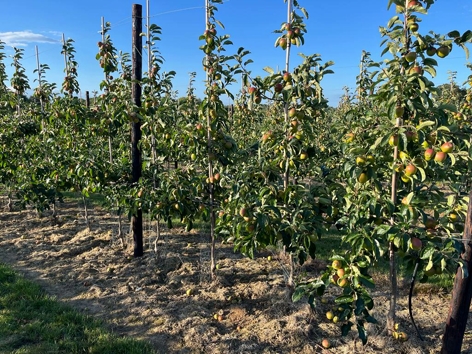
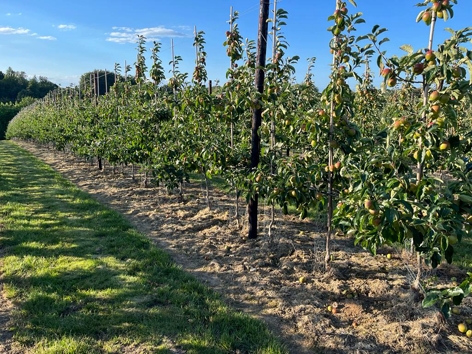
EKFS Winning Orchard 2023 - Magic Star - Bekesbourne Farm
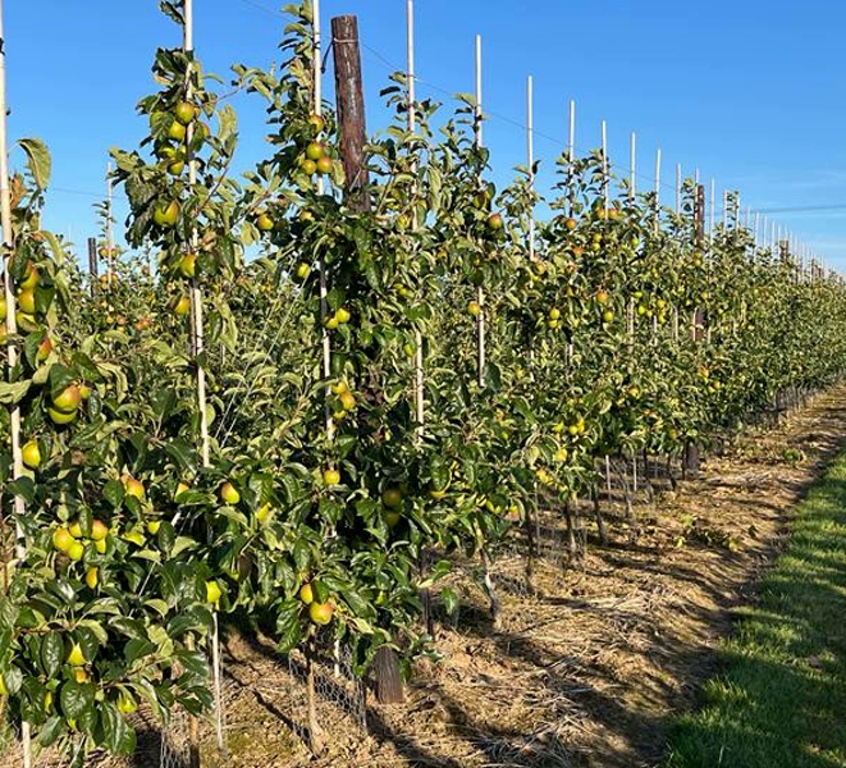
Pruning
Asked by a member of the group about pruning, Will said pruning is more akin to conference pears, looking for a wine glass shape, upright wood to keep them growing and apparently colouration is better on upright wood, lots of tipping/klik pruning.
Magic Star is a tree that like's to grow and Will said they remove any weak 'floppy' branches, particularly those lower down. and cut into the extension wood on each branch.
Thinning
Thinning concentrated on branch ends to keep upright and reduce broken branch risk on young trees.
Scab
In this difficult season, with long periods of rain. scab is an industry wide challenge. But Magic Star bred with Organic production in mind, has a scab free parent. So this season is a perfect one for 'testing the reality'
Will & David said "We found zero scab this year, 10 day program mainly using scab fungicides will a dual action on mildew, there's consequently no mildew either, lots of feed applied through leaf, NPK, Mg, Mn, Boron and Zinc.
Also Scab fungicides help to reduce canker risks!
In June 2019 The English Apple Man Joined Nigel Jenner and members of Avalon PO on a visit to Belgium.
Click on MAGIC STAR in Belgium
-------------------------------------------------------------------------------------------------------------------------------------------------------
Below: Mark Tully (facing) and Stephen Tully update storage information
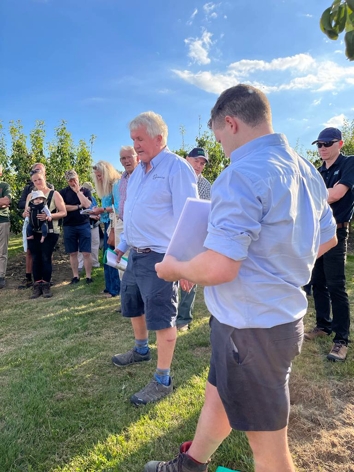 In keeping with previous years, Mark Tully from Landseer updated EKFS members on storage management issues.
In keeping with previous years, Mark Tully from Landseer updated EKFS members on storage management issues.
Mark Tully's son Stephen presented updates useful to growers as they approach the 2023 harvest season.
"We have developed a system to predict the date of 80% starch within apples as an indication for an optimal harvest date by monitoring chlorophyll throughout maturation. This has been put to use over several years".
We have been working with TrinamiX to develop a product for UK specific apples that can detect dry matter, brix, and acidity.
To summarise;
"We are looking to learn from our mistakes from the 2017 season, with the goal of reducing Stem end browning occurrence in Gala during the storage period. In 2017 we had a sequence of events such as late April frosts, warm June, wet July and cold nights in August.
This has so far been a mirror of what we have seen in the 2023 growing season with the cold northerly winds during flowering, warm June, wet July and cooler first part of august and also a larger fruit size.
The warm 2017 June led to lower calcium levels during the critical period of cell division. Studies in the USA, have shown that "As a rule, there is more chilling injury, such as internal browning, when the temperatures in the orchard in July or August drop below the 30-year average." Dr Chris Watkins, Cornell.
It was found that a larger fruit size was linked to an increased likelihood of stem end browning occurrence, so a knowledge of fruit size at harvest will be useful for determining risk of stem end browning(eg Landseer's Fruit sizing Croptracker offering).
To reduce the risk of internal browning it is advised to undergo stepwise cooling and delaying the imposition of CA atmospheres, see attached slides for table. As an additional proactive measure rigorous shelf life testing in February storage samples would identify any potential risk of stem end browning. By applying these lessons learned from 2017 and using insights from both domestic and international research, we look to enhance the quality and longevity of our British Gala apples during storage.
Click on LANDSEER Ltd for a deeper understanding of the science and technology based services they offer growers.
![]() That is all for this week
That is all for this week
Take care
The English Apple Man